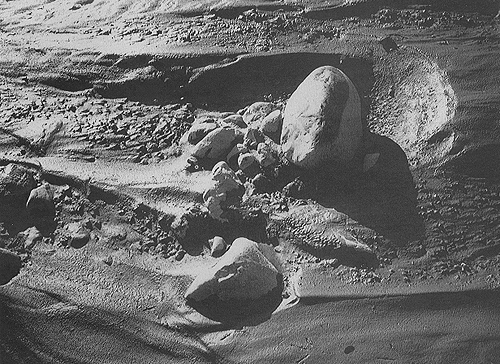
Obstacle scours (crescent marks)
Plate 82

Obstacle scours (crescent marks)
Plate 82
On a rough bottom, the boundary flow lines of a current are subject to various disturbances, as we have seen in describing bed forms and pebble clusters. Flow separation and reattachment can occur in many ways. In front of a protruding object, for example, the compression of the flow can cause either a jump of flow lines, with the formation of a shadow zone, or a focusing of energy. Deposition follows in the first case, erosion in the second. When erosional effects dominate, the eddies of the turbulent current impinge both in front of the obstacle and on its sides, forming a lunate, or crescent-shaped scour.
In the case illustrated here, the rear of the largest pebble was protected from turbulence, which favored deposition; the shadow zone is marked by a pebble cluster (see plate 66). On the back of smaller obstacles, only a thin ridge of sand accumulated. The photo was taken on a river bed, after a flood.
On a much larger scale (kilometers and tens of kilometers), similar scours (moats ) are made by bottom currents around relieves of the ocean floor.
Note, at the bottom, the marks left by the claws of a bird, and compare them with the fossil analog seen in plate 148.